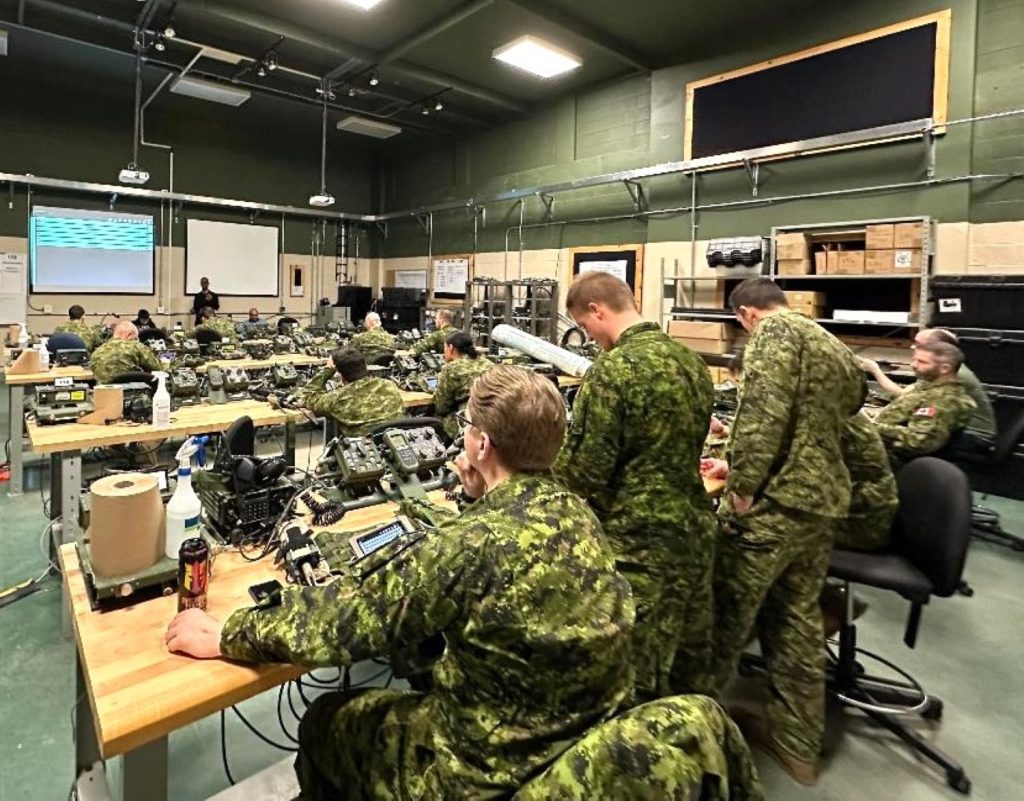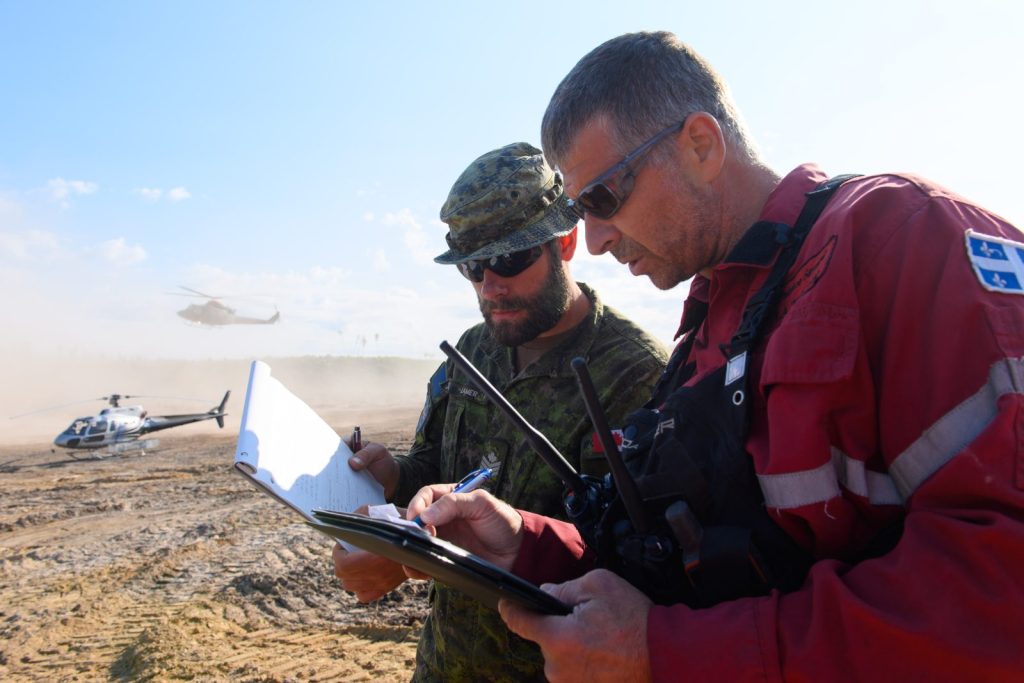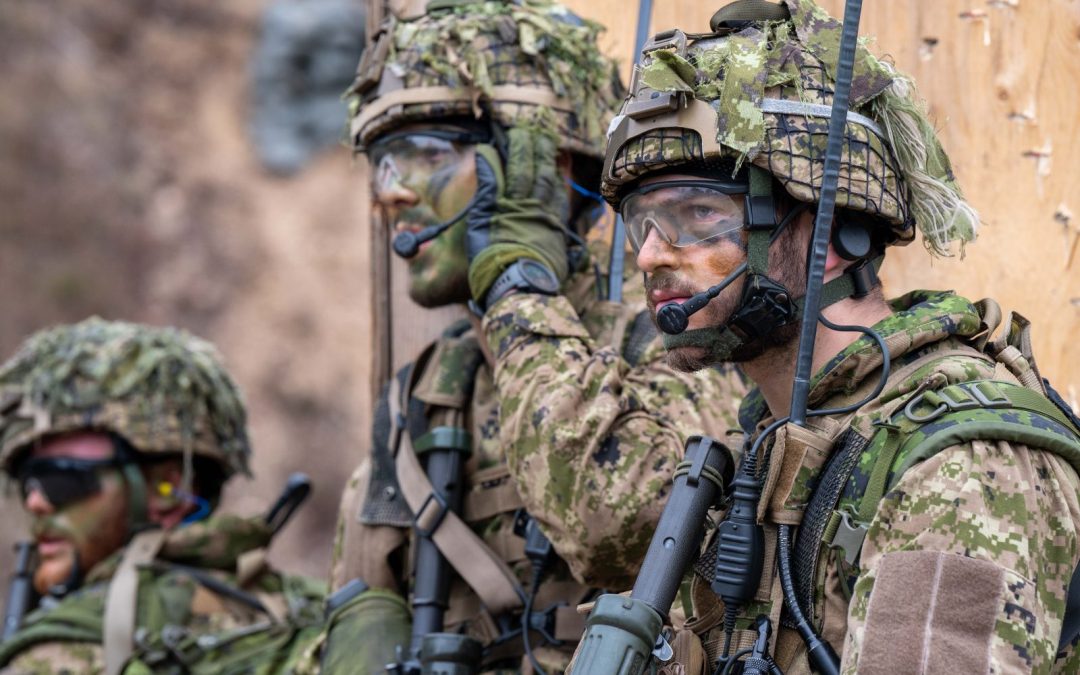by Chris Thatcher
It wasn’t quite an unfair advantage, but it was certainly an edge. For the first time on Exercise Maple Resolve, the opposition force (OPFOR) came equipped with a tactical mesh network. And in a peer-on-peer scenario, where the speed of decision making can be a deciding factor, the enemy used their newfound digital capability to great effect.
Maple Resolve is the Army’s culminating validation exercise. While a strong and creative opposition is a key to testing the capabilities of the primary training audience, any advantages in weapons or other systems are often simulated. But with the Army keen to seize every opportunity for digital experimentation, providing the 12 Regiment blinde du Canada (12 RBC) with a cloud-based tactical network to employ in its fight against the 1st and 2nd Battalions of 5 Canadian Mechanized Brigade Group (5 CBMG) was quickly recognized as a worthwhile trial.
Armed with a Tactical Assault Kit (TAK)-enabled tablet and UHF radio, members of 12 RBC, augmented with a company from the 1st Battalion and troops from 5 Combat Engineer Regiment, were able to quietly share the positioning and movements of their own force, locations of enemy units identified through reconnaissance, and terrain features – manmade and natural – on a digital map and text chat function.
“It left a lot more time and space for commanders to discuss risks, decisions and opportunities,” observed Lieutenant-Colonel Nicolas Lussier-Nivischiuk, commander of 12 RBC. “You could see even within two to three weeks the speed of adaptation on the battlefield.”
With sound situational awareness of its force and knowledge of their proximity to many enemy units, 12 RBC was able to disperse and converge its operations far more effectively than previously, he said. “From a command-and-control (C2) perspective, that made us more resilient and less prone to targeting. We never assembled for orders or back briefs. We were able to send tactical graphic orders through the system – it would appear on your map.”
And “because the net was not clogged with situational awareness issues, when we decided to converge, it was easier. We could act on decision points a lot faster,” he said. “It accelerated our decision cycle and supported the manoeuvre warfare approach.”
With accurate bearings on a digital map, crew commanders were able to focus on terrain rather than a map, improving navigation. And without a need to conduct logistics reporting via radio, unintentionally sharing grid positioning, 12 RBC was better able to track supplies, conduct vehicle recovery behind enemy lines, and “prevent the logistics train from falling too close to the enemy or into traps.”
Perhaps most significantly, 12 RBC was able to adapt the lessons from Ukraine and Nagorno-Karabakh, employing the tactical network to call for fires more rapidly.
“It was not always 100 percent, we still had to confirm details, but it was a great improvement,” said Lussier-Nivischiuk. “It increased the speed of decision making at every level.”

An AWS engineer provides familiarization training to members of 12 RBC. Photo: Vaibhav Sharma
MULTI-STAKEHOLDER CONTRIBUTIONS
That there was a network at all for Maple Resolve was due in large part to the effort of Major Martin Simard of the newly named Directorate of Digital and Army Combat Systems Integration (DDACSI), formerly the Director Land Command and Information.
When 2nd Canadian Division (2 Div) indicated an interest in digitizing the OPFOR for the culminating exercise on 5 CMBG’s build to high readiness, Simard, a former member of 12 RBC, immediately saw a problem. With the brigade’s Signals personnel at about 60 percent effective strength, any digital solution could not be reliant on their limited capacity.
That fall Amazon Web Services (AWS) had delivered a professional development session to about 80 people from Army headquarters and others with an interest in the burgeoning digital transformation effort. Among the points of discussion was a cloud-based tactical network. It might have been part marketing pitch, but Simard saw the possibility. “Why not try them out?” he asked.
He’s still not sure if that was the wisest call. For the next five months, helping to deliver a tactical network became his all-consuming job.
Following a meeting with many of the primary operators in Valcartier in November 2022, AWS developed several technical courses of action to bring the network to fruition and permit data to move throughout the battlefield. But those came at a cost, from several hundred thousand dollars to over $4 million. Without the mechanisms to procure the necessary equipment or lease it from AWS, “we were back to square one,” Simard admitted.
He’d seen the problem coming. Pulling on existing agreements with companies such as Base Camp Connect, Inter-Op, Rheinmetall and L-3Harris, and equipment already in the Army inventory, by late January 2023 he had cobbled together the components to integrate with AWS’s cloud computing services to deliver a rudimentary edge network.
“This required a little bit of investment on our part,” he said, “But it was equipment we had in the system, or we had the procurement mechanism to do.”
Once 12 RBC conducted some familiarization training with the equipment and network in late March, there was a mad dash to get everything from Valcartier to the Wainwright training area in eastern Alberta, for what is known as the engineering week prior to the start of Maple Resolve. Not everything arrived, prompting a call to the 3rd Canadian Division in Edmonton. But once most of the technical issues were resolved with all the supporting companies and 12 RBC, Simard stepped aside and left the project in the hands of 2 Div technicians.
“I believe it was a good lesson for all the stakeholders involved, working together and knowing the limitations of others,” he said. “It wasn’t a tactical network as promised, as I would have liked it to be. But considering the timeframe, it was incredible work from everyone.”
The trial marked a new step for AWS, which had not previously worked in the field with the Army. A small team of technicians tried to rapidly tailor AWS’s services to the Army network requirements, and “bring cloud computing right to the tactical edge,” said Ray Hession, National Security and Defence Leader.
AWS provided the computing and data storage for robust “edge devices” with situational awareness and C2 applications, he said. “That was extended over the course of the exercise to add some analytics capabilities … [collecting data] for the purposes of playback for an after-action review or for future simulations.”
Cloud-based computing brought “a whole lot of speed and agility” to building the network, Hession noted. And AWS adopted its customer-focused culture to a mission focused, iterative approach with “two-way door decisions” to allow for rapid testing that kept options open for alternative solutions.
That in turn allowed for what he called “undifferentiated heavy lifting,” allowing the Army to focus on the exercise while AWS focused on the background cloud support structure to the network.
If the primary objectives were to trial the Everything as a Service (EaaS) concept, including the procurement mechanisms to make it happen on short notice, and then to deliver a tactical network for the exercise, “I can say this was a success, from the user point of view and from the strategic point of view,” said Simard, a Signals officer who deployed to Afghanistan for 10 months in 2009-2010 as a non-commissioned member.
Given the no-fail requirements of Maple Resolve, there were legitimate questions about conducting an experiment so quickly, he acknowledged. A longer and slower approach might have delivered a better and more robust network. But the outcome proved an edge networked could be configured, installed, and integrated in a matter of weeks, with multiple industrial partners, despite inadequate procurement processes for acquiring small quantities of kit – albeit with the extensive effort of one exhausted Army integrator.
When he spoke to Canadian Army Today, Simard was in the process of gathering a lessons learned document from all the participants. “We can get best practices from the civilian side and integrate them into the Army,” he noted.
For 12 RBC, the digitized systems noticeably helped reduce the sensor-shooter link, “from recon to fires,” said Lussier-Nivischiuk. “Once fires were sent, we operated from dispersed to convergence, a concentration of forces. That manoeuvre was enabled by digitization.”
Other than massing fires, the unit did not change its tactics, techniques or procedures to play the enemy force, but it did leverage everything the network provided, he said.

Photo: Cpl Marc-Andre Leclerc
INTO THE FIRE
Days after Maple Resolve wrapped and the network equipment was in transit back to Valcartier, Simard got a call. More than 120 forest fires had ignited on a single day, June 1, from lightning strikes across Quebec. One fire alone would eventually consume 460,000 hectres.
Regular and Reserve members across 2 Div were on notice to deploy under Operation Lentus, the Canadian Armed Forces response to domestic requests for assistance. But with the Army’s battle management software system retired, the division would need a way to network its soldiers, and to integrate them with provincial firefighters and police on a common operating picture.
Simard quickly saw an opportunity to create a similar edge network to Maple Resolve with a tactical server on a cloud. Using the civilian application of TAK, Team Awareness Kit, the military and provincial agencies could access a common map, share information, and conduct text chats, all from their personal cell phones.
Within three days, he had reconnected with AWS and other stakeholders, established the server, and transferred the “viable solution” to the division’s digital transformation shop to run. To ensure everyone could connect and share even when 4G LTE coverage was not available in remote areas (or if cell towers burned down), he brought in Ottawa-based NORTAC Defence to help with connectivity.
NORTAC had been providing the Department of National Defence — and by extension the Army — with satellite-based short burst data asset tracking under a contract that was re-awarded several times since 2011. By incorporating WAVE, a small handheld device that provides two-way chat messaging, NORTAC was able to ensure TAK-enabled data such as position location information, overlays and other files, shared on the AWS cloud, could be pushed through the Iridium Short Burst satellite network when cell service was not available.
“Within a span of a couple of days, even though we had never done this together before, we were able to get everybody to communicate and ensure redundancy and consistency in having asset tracking and communication, regardless of where they were located,” said Martin Bouchard, NORTAC’s chief executive officer. “We were able to point that through their ATAK solution and bring everybody together on that same platform.”
Redeploying the cloud structure from Maple Resolve in a commercial cloud-based operation so soon after the exercise, though regrettable given the circumstance, was a great opportunity to provide Army leadership with complete visibility of troops and helicopters supporting the firefight, all on their cellphones, Hession observed.
“We demonstrated a lot of the benefits that cloud computing can bring, that you can deploy anywhere in the world in a matter of minutes once you’ve built your capability because it is all the same platform.”
Having an established cloud provider was a key to acceptance and success, Simard noted. On Op Lentus, the Army is a supporting player and cannot dictate solutions. Ideally, a system like this is planned and integrated with government and civilian agencies well before an incident, “so they are not trying to integrate live while fighting a fire,” he said. “They don’t have time or capacity. We have to make sure to have this as a permanent solution before next March, so it is ready for the next flood, the next forest fire.”
Still, the firefighting response allowed DDACSI to observe a cloud server in an unclassified civilian-military environment and gather feedback on how data is accessed and shared. “That was the point with my boss: We don’t know cloud. We need to start knowing cloud to be able to use it in the future,” said Simard. The cloud was attacked almost immediately, highlighting the need for added cyber defence in a military environment.
DDACSI is now focused on an Army-wide, scalable cloud-based tactical server that would be independent of the Army’s Land Command Support System (LCSS), which operates as a secured/secret environment. “We are still designing the next LCSS architecture,” he noted. “We don’t know yet the part that cloud will play. But this type of use for domestic operations is a really good use case … that could inform that.”
The permanent solution, a project called Cloud TAK-PB, should be able to connect with different tactical servers that allow for the movement of both designated and undesignated information, visible to those with the appropriate clearance, he said.
For NORTAC, the success of information sharing in remote and austere conditions has opened the door to the Integrated Soldier System Project (ISSP), an ongoing effort to network dismounted soldiers at the platoon level and below. NORTAC’s WAVE device, with encrypted messaging, is being considered for the integrated suite of systems on the ISSP tactical vest.
“As part of ISSP, they will have their cell and their radios, and [Simard’s] goal is to include the Wave, our software and our platform,” said Bouchard. “Everything is preconfigured. That way the soldier doesn’t need to determine which device they need to use, depending on the environment or the situation they are in. They have the entire kit on them, and the technology will ensure they have communication at all times.”

